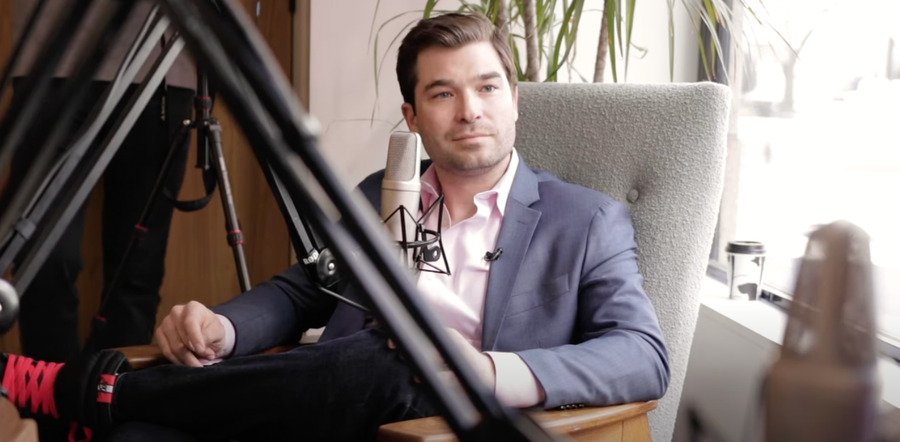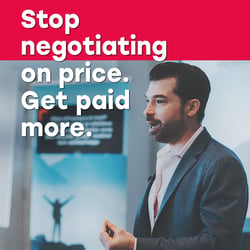The B2B Sales Strategy That Leading Sales Pros Live By
It’s a fact that every salesperson knows but doesn’t like hearing: A minority of sales reps close a majority of the deals. Joining that minority league is difficult and takes time, right? In reality, it’s as simple as changing your B2B sales strategy.
Before you say to yourself that this is nothing but guru clickbait, keep in mind that strategy is central to sales success. Unless your strategy is in order, almost nothing else matters.
I’m sharing the exact B2B sales strategy that the minority of sales professionals rely on to close a majority of the deals. Additionally, I’m sharing how you can start implementing this exact strategy TODAY.
You can keep using the same old strategy, but you’ll continue to:
- Lose dream clients;
- Get ghosted; and
- Miss quota.
Selling is not difficult or complex. If it feels that way, it’s because you’re making it that way!
While you’re shooting yourself in the foot, top sales pros will be gliding along thanks to this exact sales strategy.
The Benefits of Having a Solid Sales Strategy
Having a solid sales strategy benefits both you and your potential B2B buyers. And while there are many benefits, these two are the most important:
- You and your sales team have a blueprint to manifest your sales vision
- Prospects build trust in you as an irreplaceable expert
First of all, having a great strategy benefits you and your sales team because it acts as a blueprint to help you bring your sales and business visions to life.
Before a strategy, all you have is an idea in your head of what you want to happen. But now, you have a plan of attack to turn that vision into reality.
Moreover, a strategy takes your big sales vision and makes it possible to achieve by giving you the guidance to execute it. Suddenly, the impossible vision becomes possible because you have a thorough blueprint to bring it to life.
Second, having a sales strategy impacts the way that you make your customers feel. More specifically, a sales strategy invokes the kinds of positive feelings in prospects that motivate them to make purchasing decisions.
When they’re going through their buying process unsure of what’s best for them, your sales strategy will make them feel as if they can rely on you for success. Why? Because you’re the expert with the blueprint!
Furthermore, having a strategy gives you the blueprint you need to manifest your sales visions while refining your sales approach so that prospects see you as an irreplaceable expert.
What Happens When You Don’t Have a Strategy?
On the flip side, not having a strategy is like:
- Trying to build a house without a blueprint
- Expecting prospects to take you seriously when you don’t have a plan
First off, if you wouldn’t try to build a house without a blueprint, then you wouldn't try to close sales deals without a strategy. How do you expect to turn a vision into reality without a plan to do it?
Second, how do you expect prospects to take you seriously if you don’t take your selling process seriously the way an expert would?
Not having a strategy and expecting prospects to take you seriously is like being a home builder who doesn’t have a blueprint to build a house yet still expects homebuyers to take them seriously.
Furthermore, not having a strategy, or even having a subpar strategy, is a disaster waiting to happen. It’ll prove nearly impossible to close deals, and eventually business will tank.
-Mar-17-2022-12-17-21-96-AM.jpg?width=900&name=1%20(1)-Mar-17-2022-12-17-21-96-AM.jpg)
The 1 B2B Sales Strategy That Sales Experts Live By
If you’ve done some digging into sales strategies before, then you’re probably already familiar with the old run-of-the-mill, textbook strategies.
More specifically, you’ve probably heard of these 4 selling strategies, including:
- Strategic selling
- Solution selling
- Social selling
- Account-based selling
I’m not here to hate on all these basic selling strategies. The truth is that there is some good in each of them. Yet, top sales professionals who close a majority of the deals aren’t relying solely on these strategies for guidance.
Rather, they’re using what I will informally call the Physician Selling Strategy.
The Physician Selling Strategy utilizes the same approach that expert physicians use to gain their patient’s trust, and then eventually diagnose and treat them.
Think of it like this: When a patient meets a new doctor because they are experiencing pain, the physician first utilizes a set of techniques to gain the patient’s trust. For example, they’ll spend several appointments asking questions and running analyses before diagnosing their pain point and proposing solutions. Then, they outline a specific pathway for the patient to overcome their pain and live a better life. Thanks to the way they approached the process, the patients see their physician as somebody who they depend on in order to live their best life.
If you want to join the league of minority sales pros, you need to adopt the same strategy that physicians use to gain the trust of their patients.
The entire goal of the Physician Selling Strategy is to get B2B customers to trust you as an expert who they can’t afford to live without, just like how patients trust their physicians as irreplaceable and invaluable experts!
Transform Yourself Into an Irreplaceable Expert
From now on, you need to embrace yourself as an expert who prospects can’t afford to lose. Approach your selling process like a physician with invaluable wisdom to bring to the table.
To reap the benefits of this sales strategy, you must:
- Carry yourself like the unique expert you are rather than a replaceable vendor; and
- Use sales techniques that enhance your expertise.
Just below, I am showing you how to do these two things in order to put the Physician Selling Strategy to work.
Here’s How You Can Put This Top Sales Strategy to Work Starting Now!
What’s stopping you from being a part of the minority of sales pros who close the majority of deals? To put it simply, you’re the only thing that’s stopping you.
So get out of your own way and get to work by putting this exact sales strategy to use! Remember, the key is to elevate yourself to irreplaceable expert status. It’s as simple as that!
If there’s going to be somebody who crushes the sales game, it might as well be you.
1. Clear Out the Fog
Do you ever feel like you’re living in a constant state of fog in which you don’t know what to do because you can’t even see what’s right in front of you?
If so, then priority #1 is clearing away that fog. Unless you clear out the fog, then the sales strategy will be worthless.
But what creates this fog in the first place?
That fog is created by a mental pile-up of thoughts related to:
- Not understanding your customer base
- Being constantly distracted by small problems
- Having an overwhelming amount of work to tackle
Top sales professionals have strategy success because they start with clarity. Trying to put the strategy to work without having clarity is no different than trying to drive your car in the middle of a thick haze. Sure, you might get to your destination, but not without the crippling anxiety of driving over a cliff.
Get Feedback From Your Current Customer Base
How often do you have customers coming to you saying, “This isn’t what we wanted” or “We thought that you were going to do X, not Y?” Doesn’t it make you feel completely helpless and add to the fog occupying your mind?
Help clear this fog away by regularly connecting with customers to gather feedback.
Rather than spending months on a project only to turn it in and have customers scratch their heads, ask for feedback throughout the process.
Additionally, use feedback from existing customers to gain a better understanding of your general customer base, and then apply those understandings to your lead generation process.
Focus Your Intentions
You’ll never get out of the fog unless you’re focused. More specifically, unless you’re 100% focused on your most important tasks and accomplishing them without letting other problems steal the attention.
How often do you show up for work each day knowing what you have to get done, but then all of a sudden LinkedIn notifications pop up, team members are emailing you, and everyone is begging for your attention? Then when the day is over, you realize that all you did was put out fires rather than get actual work done.
Sound familiar?
To avoid focus traps, start time blocking your days. For example, on Sunday night, set your schedule for Monday by blocking off sections of time to accomplish specific tasks. Be extremely deliberate and strict with blocking! Come Monday, follow those time blocks to a T so that you can stay focused on what’s more important.
Remember, just because you feel “busy” doesn’t mean that you’re actually getting important tasks done!
Delegate to Your B2B Sales Team
Does an expert physician run an entire practice by themself? Of course not! In addition to the doctor, there are nurses, technicians, coordinators, and so many other people there to make the machine work.
Just like how physicians delegate, you need to do the same!
While you’re focusing on leading the team and implementing the strategy, your team members should be focusing on checking the other boxes.
No more micromanaging or focusing on the most menial of tasks. Instead, you must focus on the biggest sales tasks at hand.

2. Ditch the Traditional Sales Funnel
Are you a religious user of traditional sales funnels?
If so, that ends here and now!
Although funnels are used by most business-to-business sales teams to model the customer buying process and sales cycle, they’re actually flat-out useless and undercut the impact of the selling strategy.
How?
To put it simply: Sales funnels take control of the selling process out of your hands and put it in the hands of prospective customers.
This directly contradicts the top-selling strategy because expert sales professionals are ALWAYS in control of the selling process, just like how expert physicians control their patient’s recovery process.
Bottom line: Unless you want to completely undo the potency of your strategy, ditch the funnel!
Always Stay In Control
Now, you might be thinking, “Why is it so important for me to stay in control versus my potential buyers? Won’t my being in control turn them off?”
First off, being in control doesn’t mean that you’re a control freak. Rather, it means that you’re the one guiding the prospect through the buying process versus them guiding you.
Secondly, it is absolutely crucial for you to stay in control because you’re the expert who knows what their prospect needs to solve their pain point. On the other hand, prospects don’t even have a clue what they need, because if they did, then they would have already solved the pain point.
When a patient goes to see their doctor, the doctor never lets the prospect take control by asking, “So, what do you think the problem is?” Instead, they simply ask questions about their symptoms and then offer a diagnosis.
If you don’t think that you would be the kind of physician who lets patients diagnose themselves, then you’re not the kind of salesperson who would let potential customers take control by telling you what they need to solve their pain point.
No Free Proposals
Just about every sales funnel suggests that you send out initial proposals to leads.
However, free proposals are perhaps the absolute worst technique in the sales toolbox, because they hand control of the sale over to the prospect on a silver platter.
Don’t believe it? Just think about all the times you’ve sent over a proposal only to get ghosted by a lead.
Instead of handing out free proposals like they’re candy thinking that it will influence customers to make buying decisions, take back control of the sales process before it’s too late.
3. Crunch Your B2B Sales Process
Experts are direct. When they have something important to do, they don’t beat around the bush or waste time. Rather, they keep things as straightforward as possible.
As a result, their sales process is short and sweet!
Unfortunately, many salespeople elongate the HECK out of their process because they’re extremely indirect. While they’re indirect in many ways, they’re the most indirect when it comes to:
- Qualifying their target customers; and
- Following-up.
Nobody likes a long selling process. Therefore, crunch it down by being as straightforward as possible. NEVER beat around the bush.
Don’t Waste Time on Unqualified Leads
When it comes to elongating the sales process, many sales reps waste an exceeding amount of time on leads who are unqualified.
In an effort to siphon as many leads into their sales pipeline as possible, they simply throw a net out into the sea and take whatever they catch. What they really should be doing is getting super strict regarding who a qualified lead in their target market is.
From here on out, stop playing the quantity game and start playing the quality game!
If getting super strict with qualifying leads reduces the number of leads in your pipeline, just remember that it’s marginally better to have a handful of quality leads versus many unqualified ones.
Follow-Up Immediately
So you get a potential customer on the phone after making a cold call... How much time do you wait to follow up with them for the next meeting? 1 day? 2 days? 1 week?
To put it simply: The more time in between the initial cold call and the initial sales meeting, the less likely you are to close the deal. Why? Because the more time in between meetings, the more time the customer has to:
- Second-guess themselves
- Look for other options
- Come up with objections to working with you
Therefore, after making your initial round of outreach, set up the first formal sales meeting ASAP. If possible, do it the next day!
4. Hone In on the Buyer’s Journey
The best sales experts create the best buying experience for their customers.
For example: When you go to a fast-food restaurant, the food tastes fine, but all you do is eat and leave. On the other hand, when you go to a Michelin Star restaurant, the servers do everything in their power to make your meal not just a meal, but a complete dining experience.
From now on, curate the ideal buyer’s journey by:
- Customizing each prospect’s buying experience
- Going the extra mile for the decision-makers
- Providing resources to help prospects make the right decisions
Ultimately, honing in on the buyer’s journey helps build relationships between you and your prospective customers.
Customize the Buying Process
A recent survey revealed that 76% of B2B companies say that there is a lack of customization and personalization in their buying experiences.
Expert sales reps are among the few who make prospects feel like they’re respected individuals rather than boxes to be checked.
You can do the same by:
- Listening more than you speak
- Adding small customizations to your deliverable to fit the customer’s needs
- Spending more one-on-one time with decision-makers
Small changes in the way you sell can make prospects feel like the buying process was curated especially for them.
Add Value With Your B2B Marketing Strategy
Help make your prospect’s decision-making process easier by adding value with content marketing.
As they’re going through the buying process, prospects want assurance that you’re the right person to solve their pain point.
Rather than leaving them out on their own to dig up some dirt on you, use content marketing as a tool to show them that you’re the right person for the job.
For example: Sharing case studies on social media, recording webinars, and adding resources to your website provides immediate value to the customer while assuring them that you know what you’re talking about.
Never forget that there is no such thing as something for nothing. You can’t expect prospects to give you their time and energy without giving them something first.
Content is an excellent way to reciprocate the value that your potential customers are giving you during the buying process.

5. No Negotiating Price
Would an expert surgeon negotiate the price of surgery? Would a Michelin Star restaurant negotiate the price of a dish on their menu? Never.
If you want to portray yourself as an expert, then never openly negotiate your price tag. Once you set your price, you need to stand firm in it.
Now that isn’t to say that you shouldn’t be flexible with prospects. For example, offering payment plans is a great way to offer some flexibility while still sticking to your number.
This doesn’t mean that you can simply throw out any number you want and expect prospects to pay for it. That said, you need to set a fair price tag that equals the value of your deliverable and its delivery.
From now on, there is no more negotiating. That is, at least, unless you want to be viewed as a replaceable vendor.
Final Thoughts on the Strategy That Only Top Sales Reps Use
This top B2B sales strategy will help you solve almost any sales-related problem. Whether you want to close more deals in less time, establish better customer relationships, or simply stop being treated like a vendor, then you’ve come to the right place.
The simple and straightforward secret sauce is all about you embracing yourself as an expert and not being afraid to put that fact out there. While your competitors are all vendor-ifying themselves, you need to be elevating yourself to irreplaceable expert status.
Joining the leagues of top sales pros who close a majority of the deals starts with putting this strategy to use. If other people are winning the sales game, why shouldn’t you?
You May Also Like
These Related Articles

10 Terrible & Pervasive B2B Sales Tips To Be Aware Of

10 B2B Sales Tactics That Get Leads Running to You




